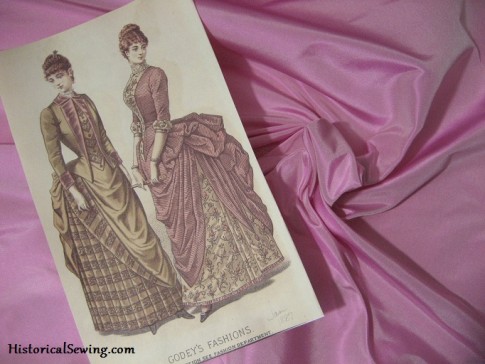
We’ve all been there. Standing in an aisle of gorgeous fabrics… swooning at the computer screen… gazing lovingly (and with drool at the mouth) at THE.PERFECT.FABRIC for that next dress.
Question is… how much to buy??
Will 5 yards be enough? 10? Or do I have to sell a kidney to afford some unmentionable amount of fibers woven together into a textile?? (“Think I’ll just get a yard and use for trim some time.” hehe)
I’ve compiled a list of common garments from the 19th Century and their approximate yardage requirements. Please note – these are *approximate.*
You’ll have to adjust for larger or smaller material widths and for your size (i.e. a 4’11” person will take less yardage than my 5’8″ mother). Take a look at this conversion chart for when you find that “must have” fabric.
The yardages listed approximate using 45″ fabric. If you find a to-die-for silk taffeta in 58″ you might not need as much. Also, if you plan on creating self-trim – you may need several more yards. For ruffles use these calculations. For pleating read this article.
These yardages assume cutting the garment pieces on the “normal” grain for the era – most often “on” grain for bodices and skirts and bias cut for sleeves.

Regency Era c.1800 to 1820
- Basic Dress – 5 to 7 yards
- Evening/Ball Dress with train – 6 to 8 yards
- Spencer jacket – 2 to 3 yards
- Pelisse or Coat – 3.5 to 5 yards
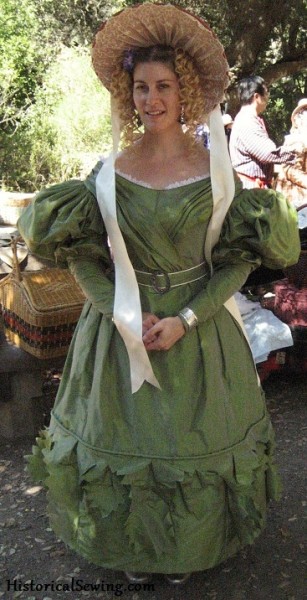
Romantic Era c.1820s & 1830s
- Bodice – 1 to 1.5 yards
- Full puffed sleeves (short), pair – 1 to 1.25 yards
- Full length leg o’ mutton sleeves, pair – 1.5 to 2 yards
- Skirt – 3.5 to 5 yards
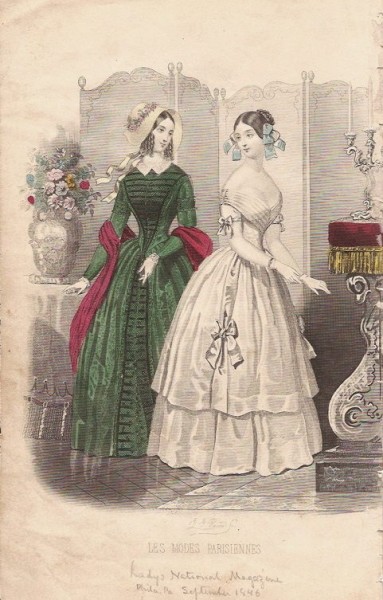
Early Victorian c.1840s
- Bodice with long, tight bias-cut sleeves – 2.25 to 3 yards
- Evening bodice with short sleeves – 1.75 to 2.5 yards
- Skirt – 4 to 5.5 yards
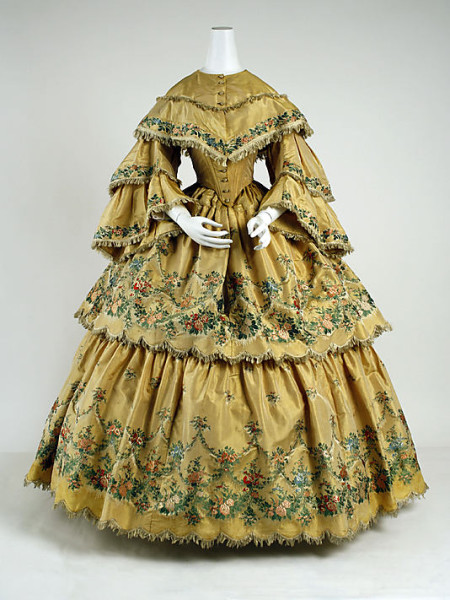
Mid-Victorian c.1850s & 1860s
- Bodice with pagoda sleeves – 3 to 4 yards
- Bodice with fitted sleeves – 2 to 3 yards
- Evening/Ball gown bodice – 1.5 to 2 yards
- Skirt, plain – 5 to 6.5 yards
- Skirt with 3 deep ruffles – above plus 7 yards
- Sheer dress – 8 to 10 yards
To determine the ruffle yardage more accurately, use this precise calculation.
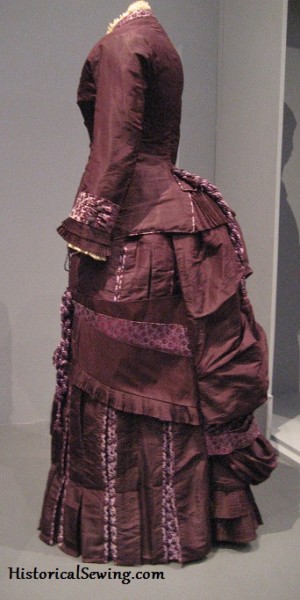
Bustle Era c.1870 to 1889
- Basic bodice – 2.5 to 4 yards depending on the length down on the hips
- Apron overskirt – 3 to 6 yards
- Foundation/Underskirt – 4 to 5.5 yards
- Foundation skirt with train – 5 to 8 yards
Eight to 12 yards is a good starting point for bustle dresses.
The Bustle years are quite varied and can greatly affect amount of yardage needed. (How foofy do you want it?)
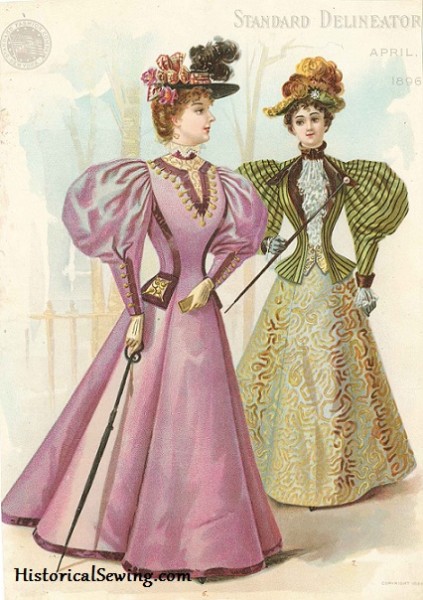
Late Victorian c.1890s
- Bodice (only) – 1.5 to 2.5 yards
- Full length leg o’ mutton sleeves, pair – 1.5 to 3 yards
- Short puffed sleeves, pair – 1.5 to 2.5 yards
- Skirt – 5 to 6.5 yards
The 1890s saw a wide variety of sleeve sizes. Keep this in mind as you select your particular costume year and how this can vary greatly as to the yardage needed.
For underlining fabrics, follow the same approximate yardage as listed.
For fabric suppliers, check out the Fabric & Trim Resource page.
Remember, it’s a good rule to ALWAYS buy a little bit more than you think you need. If you are matching plaids or stripes, cutting pieces on the bias, this will take more yardage.
Self-trims (trims, ruffles, puffs, etc. cut from the dress or complementary fabric) always take more than you think. Plan accordingly. Then use these ideas for using up any small amounts you’re left with.
Hope these guidelines help you! Let me know if I should add something or can help you further.


Hi, I’m a large woman and wold like to know how much fabric I would need for a skirt. I’m 5’3″, waist is 52″. Due to medical issues I can drop 40lbs in a few months, so I’d like to use a draw string in the waist. What do you suggest?
Yardage would depend on what style of skirt you’re looking at making. For a simple panel skirt, no longer than 30″, with drawstring waist I’d give a minimum of 3 yards (for three panels cut to length plus seam and hem allowances). For a longer length you’ll need to add more cut length for each of the three panels, which could be up to an additional yard.
For a 1840s nightgown or chemise, about how many yards would you say I’ll need? I’m 5′ 4″, have a 38″ bust, and my shoulders circumference is around 42″.
I’d allow a minimum of 2.5 yards and up to 3.5, depending on fabric width.
DO you have these estimate for other centuries as well? They’re so helpful for fabric shopping and I would be so appreciative to have estimates for 18th-century dresses as well!
Hi Nora,
As I specialize in 19th century I haven’t put any other time periods together for yardages. Specifically for 18th century you’ll find yardage amounts for lots of projects in The American Duchess Guide to 18th Century Dressmaking book if you’re inclined to get a book. (It’s fabulous BTW!).
What about for a corset? Roughly how much yardage do you think? I’m about average measurement wise. Thanks
For a corset it’s generally a yard of coutil and a 3/4 to a yard of fashion fabric. If plus-size then more like 1.25 yards of coutil.
How much for a corset cover (late 19th century)? I’m five feet ten inches but wear a size 10 bust and waist, according to the Simplicity pattern envelopes at least…
I’ll suggest one to 1.5 yards depending on fabric width. Even with short sleeves you won’t need more than 1.75 yards (in my experience).
I see only one recent comment…..is your site still active? Thank you solo much for the yardage chart/info! Do you sell patterns? What style would be good for “pioneer days” ??? I have a year to make mommy and daughter dresses! Not all that much time to sew the PERFECT dresses!
Hi Evelyn! I am VERY much still here! My shop, the Old Petticoat Shop, focuses on undergarments and accessories primarily. What dates are you needing costumes for for your “pioneer days”?
I know this thread is rather old and there’s probably no point to add more to it but just in case – I read a tip regarding such dresses about 6 years ago. I’m sorry, I don’t remember the title of that book, it was something about historical materials and recreating clothes. It was something along the lines – ALWAYS buy 20-30% more than you need. It’s not for stripes and patterns but for repairs when it may be impossible to buy the same fabric. Also – If you buy the same fabric, it’s possible that your dress faded in time and your new fabric is new so the shades don’t match but with the fabric as old as your original dress it should be easier. In some cases it’s not identical as it is possible to keep your fabric in a box so it doesn’t fade or does fade but less than a dress used daily.
Please forgive me my errors, English isn’t my first language. I did check spelling but my grammar – not sure. No offence meant.
It is ALWAYS a good idea to buy extra yardage! 🙂
Oh, I might have to put this in a chart and tuck it in my husband’s wallet. He often gets to the fabric store since it is on his way to work (40 miles from home). He’s looking for yardage for shirts, but he often finds stuff he thinks would look great for my dresses. It’d save him a call and he might be able to actually surprise me with a present. BTW, he also shops for my quilt fabric. The ladies at both stores love him, and both my boys who can buy yardage. My youngest works at W******, and to his disgust gets called to the fabric table to cut for customers a lot. Lol.
I was told years and years ago that 10 yards was the starting point for early (large) bustle era dresses. I find that to still hold true today. I am 5′ 10″, so about 6′ in low heels. I do need a tad more fabric. Ruffles are often my friend, though I greatly dislike making the buggers.
I found a nifty trick for making ruffles. I use my serger! You’ll have to look up and experiment with the settings for your specific machine, Seam Into the long strips and then hem with a rolled hem on your regular machine and then serge away! Super easy and saves tons of time. Of course the hem looks a tiny bit different, but a good ironing will flatten it right down.
I love your website, It gives such good information and tricks,, Thank you.
I’ll admit I’m a very basic serger user – but can’t live without it! lol I’ve seen people doing amazing gathers with sergers.
Thanks for your comment and for following the blog. Cheers! 🙂
What a useful guide! I almost always mess up when I’m estimating how much fabric I need off the top of my head. First I’ll buy too little for one project, thinking that I can get away with a yard less than recommended because I don’t even break 5′. Then I’ll buy way too much for my next project, and end up with crazy leftovers. This is *such* a huge help!
This will be very helpful. Thanks!
Is it possible to get a list of approximate yardage for men’s clothes too? I am about to embark on a suit for my husband and want to be able to purchase fabric before patterns if need be. Thanks for all of the good info Jennifer!
Now that’s a good idea. For now, I’d start with this list then see if the pattern links show any yardage amounts.
im from the rest of the world.
whats a yard?
A yard is slightly less than a meter. A meter equals about 39 inches and a yard is 36 inches. (1 m is equivalent to 1.0936 yards, or 39.370 inches.)
Hi! I’m also from the rest of the world, so after the first excitement of finding this super-useful article has passed, I’ve started to convert to meters. Here is the result:
Regency Era c.1800 to 1820
Basic Dress – 5 to 7 yards = 4.5 – 6.5 m
Evening/Ball Dress with train – 6 to 8 yards = 5.5 – 7.3 m
Spencer jacket – 2 to 3 yards = 1.8 – 2.7 m
Pelisse or Coat – 3.5 to 5 yards = 3.2 – 4.5 m
Romantic Era c.1820s & 1830s
Bodice – 1 to 1.5 yards = 0,9 – 1,4 m
Full puffed sleeves (short), pair – 1 to 1.25 yards = 0.9 – 1.15 m
Full length leg o’ mutton sleeves, pair – 1.5 to 2 yards = 1.4 – 1.8 m
Skirt – 3.5 to 5 yards = 3.2 – 4.5 m
Early Victorian c.1840s
Bodice with long, tight bias-cut sleeves – 2.25 to 3 yards = 2 – 2.7 m
Evening bodice with short sleeves – 1.75 to 2.5 yards = 1.6 – 2.3 m
Skirt – 4 to 5.5 yards = 3.7 – 5 m
Mid-Victorian c.1850s & 1860s
Bodice with pagoda sleeves – 3 to 4 yards = 2.7 – 3.7 m
Bodice with fitted sleeves – 2 to 3 yards = 1.8 – 2.7 m
Evening/Ball gown bodice – 1.5 to 2 yards = 1.4 – 1.8 m
Skirt, plain – 5 to 6.5 yards = 4.5 – 6 m
Skirt with 3 deep ruffles – above plus 7 yards = 6.5 m
Sheer dress – 8 to 10 yards = 7.3 – 9 m
Bustle Era c.1870 to 1889
Basic bodice – 2.5 to 4 yards = 2.3 – 3.7 m depending on the length down on the hips
Apron overskirt – 3 to 6 yards = 2.7 – 5.5 m
Foundation/Underskirt – 4 to 5.5 yards = 3.7 – 5 m
Foundation skirt with train – 5 to 8 yards = 4.5 – 7.3 m
(8 to 12 yards = 7.3 – 11 m is a good starting point for bustle dresses.)
The Bustle years are quite varied and can greatly affect amount of yardage needed.
Late Victorian c.1890s
Bodice (only) – 1.5 to 2.5 yards = 1.4 – 2.3 m
Full length leg o’ mutton sleeves, pair – 1.5 to 3 yards = 1.4 – 2.7 m
Short puffed sleeves, pair – 1.5 to 2.5 yards = 1.4 – 2.3 m
Skirt – 5 to 6.5 yards = 4.5 – 6 m
This is awesome! Thank you Kitt. 🙂
The problem my mom and I had when we went shopping for fabric for my Regency gown earlier this year is that even when we found something similar to fabric from the period, there wouldn’t be enough fabric on the bolt! Apparently the fabric manufacturers are making the bolts only 8 yards each, and the stores we went to only had one bolt, even of white lining fabric. We had to start over three times when we discovered the bolt we had chosen did not have enough fabric, and had to go to three different stores to get enough of the off-white lining fabric (which you would think would get used a LOT). Finding the trim was equally frustrating.
The gown and pelisse turned out great, but the shopping was almost more difficult than the cutting and sewing.
I’ve got a regency dress out of 3metres of fabric before…(didn’t line or face it as I have a petticoat) just bias bound the edges. (I am 5ft1 though).
Excellent! Thanks!
This is such a WONDERFUL list…it can be so daunting to fabric shop when you have no clue how many yards you need. Ditto to what Judy Bauch said too… 😀
What frustrates me is finally finding a fabric that’s ‘perfect’ for the dress I have in mind, and finding out the bolt is way too short of the amount I need… (sigh)
That helps a lot! Thanks! 😉
This would be fantastic all in a chart for easy pinning to Pinterest…just a hint (’cause maybe I want one)
This is exactly what I needed last week for purchasing 60″ wide fabric when the yardage chart was limited to 45″ – on the bright side, there will be ruffles. Thanks for posting – it’s very useful information!
Such perfect timing! I’m getting ready to order some lovely silk for my prom dress, and this will hopefully help me to guess-timate the right amount!
Many Thanks!
Yes this article takes the cake! I kind of hear a choir singing most victoriously in my head looking the yardage charts. So nice to go to the fabric store without having to wildly guestimate while someone is breathing down your neck at the cutting counter hoping you’ll leave a morsel left for them. Doubt usually sets in for me and I take the remainder on the bolt only to be stuck with three yards at the end of a project. Then I feel massive guilt for being a fiber hog, sigh!
If I don’t have a specific project in mind, I generally buy 10 yards of a fabric that catches my eye. Luckily, you can generally add in coordinating solids if there’s a shortfall. Usually I have leftovers — some day, I will be making a very spectacular crazy quilt.
Those yardages would be for average size I assume. since i am a plus size ,I would add 1-2 yards .depending on the fullness, this is what I have done for all my costumes.
Yes, average size, so those taller or with larger than, say, 42″ bust would need to add yardage.